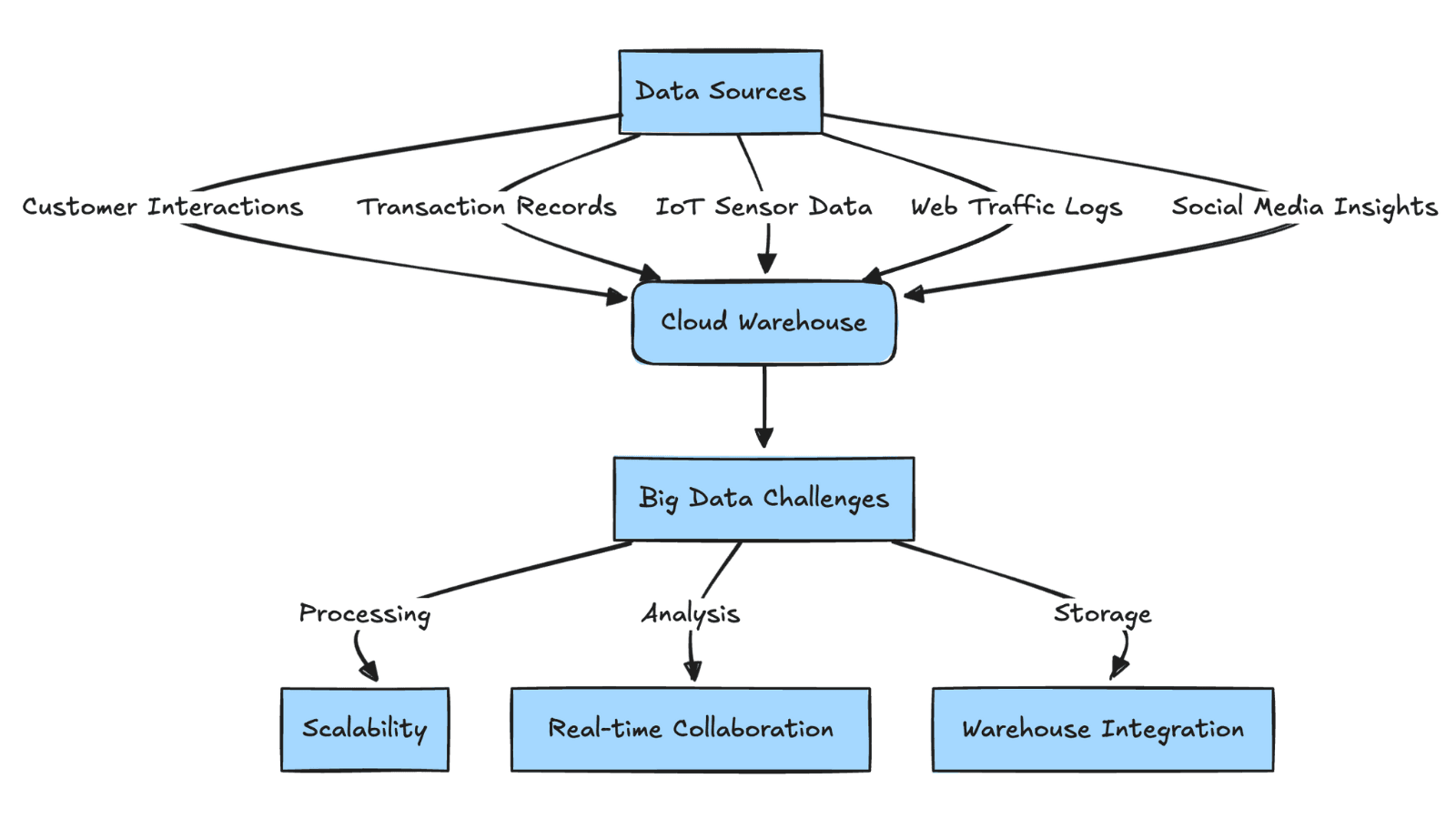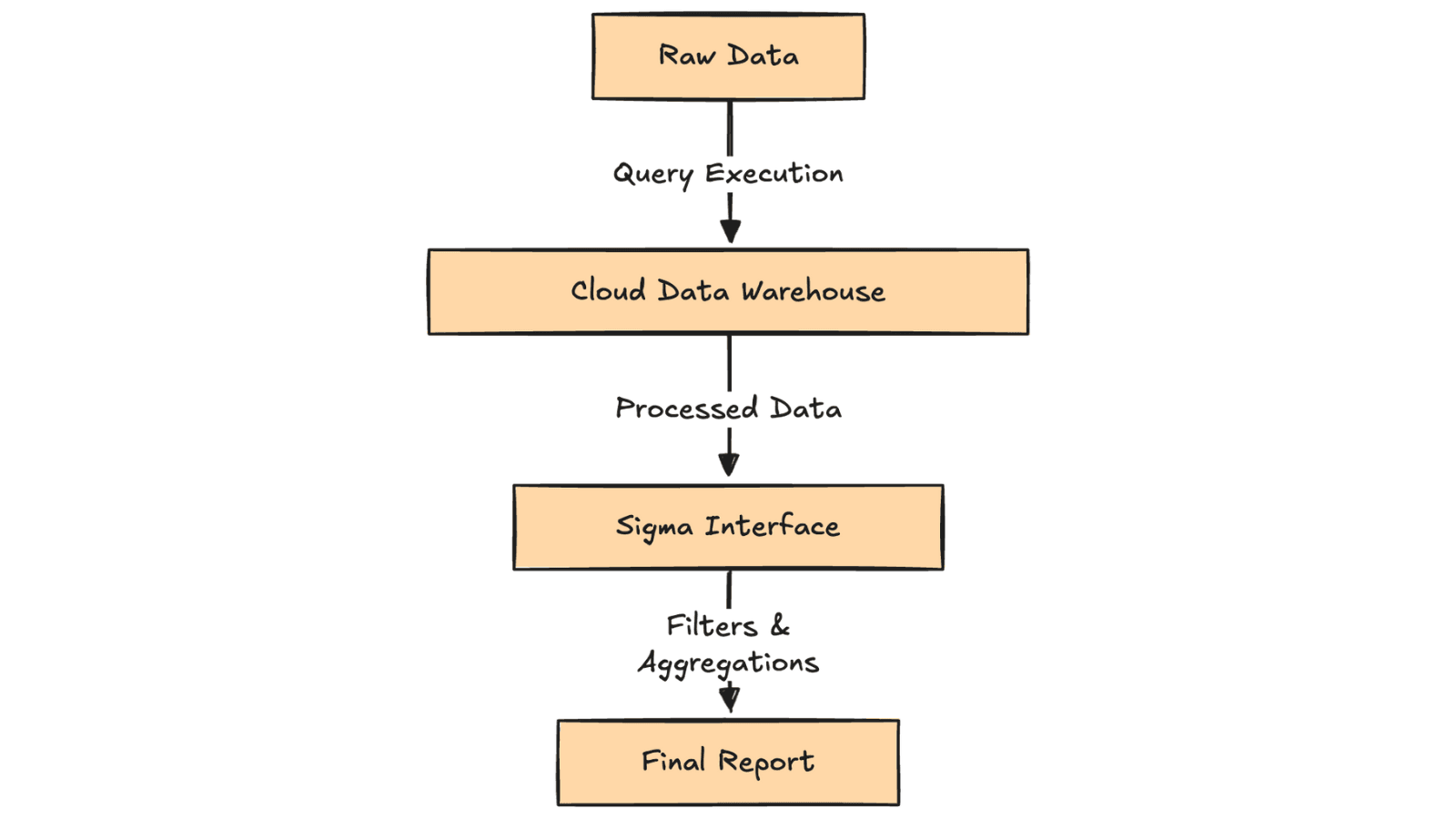Managing Big Data with Sigma Comutng
Managing Big Data with Sigma: How to Handle Complex Data Sets
Big data presents both opportunities and challenges. As organizations collect massive amounts of information, they need tools that simplify analysis without requiring deep technical expertise. Sigma Computing provides a way to explore, visualize, and work with complex data sets directly in the cloud—without SQL or coding experience.
Why Big Data Feels Overwhelming
Organizations today deal with data from multiple sources:
- Customer interactions
- Transaction records
- IoT sensor readings
- Web traffic logs
- Social media insights
Each data source generates information in different formats, at high volumes, and often with inconsistencies. Managing this complexity requires:
- Fast access to large data sets
- Real-time collaboration across teams
- Scalability to process millions or billions of rows
- Integration with cloud data warehouses like Snowflake, BigQuery, and Redshift

How Sigma Helps Manage Big Data
Sigma is built for cloud data analytics, making it easier to work with large data sets directly from your cloud warehouse and features like Data Apps, AI-powered analytics, enhanced data modeling, and expanded connectivity further improve its capabilities.
1. Work with Live Data (No Extracts)
- Unlike traditional BI tools that require data extracts, Sigma connects directly to live data. This means:
- No delays caused by scheduled refreshes
- No outdated reports based on stale data
- Always working with the most current information
- Example: If our business is tracking daily sales, we can build reports that update in real time as new transactions occur.
2. Explore Billions of Rows Without Writing SQL
- Sigma’s spreadsheet-like interface makes it easy to analyze data without writing SQL queries. Users can:
- Drag and drop columns
- Apply filters and aggregations
- Build calculations using familiar spreadsheet functions
- Use Formula Assistant, Sigma’s AI-powered tool, to help create complex calculations efficiently
- Example: A marketing team can analyze customer behavior by segmenting data without needing help from a data engineer.
3. Handle Nested and Semi-Structured Data
- Many cloud warehouses store data in semi-structured formats like JSON. Sigma allows users to:
- Extract JSON fields into separate columns
- Explore nested fields through the user interface
- Join structured and semi-structured data using table relationships
- However, JSON data is not automatically flattened; users must manually extract relevant fields when needed.
4. Optimize Performance by Pushing Queries to the Warehouse
- Analyzing raw big data can be slow. Sigma optimizes performance by:
- Pushing calculations directly to the cloud data warehouse
- Minimizing data movement by executing queries at the source
- Allowing drill-downs from summaries to details without performance loss
- Using predefined metrics and reusable tables to standardize calculations and improve governance
Note: Sigma does not automatically create aggregated tables but allows users to manually build summaries for efficient querying.

5. Build Interactive Data Apps
- Sigma offers Data Apps, which allow users to:
- Create interactive, no-code analytics applications
- Guide decision-making through customized workflows
- Go beyond static dashboards for a more dynamic experience
- Example: A finance team can build an interactive budgeting tool that updates forecasts based on real-time inputs.
6. Expanded Connectivity and Embedded Analytics
- Sigma has expanded its integrations, including:
- OAuth with write access for Snowflake and Databricks
- Azure SQL Database connector for smoother Microsoft integration
- Improved embedded analytics, offering:
- More customization for reports
- Interactive exploration for embedded users
- A more intuitive user interface
Real-World Use Cases
Retail: Inventory and Sales Forecasting
- Retailers must balance stock levels to avoid overstocking or shortages. With Sigma, they can:
- Analyze historical sales trends
- Predict demand based on seasonality
- Adjust orders dynamically based on real-time inventory
Healthcare: Patient Data Analysis
- Healthcare organizations deal with massive amounts of patient data across different systems. Sigma helps by:
- Unifying patient records from various sources
- Identifying trends in treatment outcomes
- Ensuring compliance with data security regulations
Financial Services: Fraud Detection
- Banks and fintech companies need to detect fraudulent transactions in real time. Sigma enables them to:
- Analyze transaction patterns for anomalies
- Cross-check data across multiple sources
- Flag suspicious activity instantly
Best Practices for Managing Big Data in Sigma
- Use Filters to Reduce Query Load
- Limit the data displayed to focus on relevant records
- Use date ranges and category filters to speed up analysis
- Build Aggregated Views for High-Level Analysis
- Summarize data at the appropriate level (e.g., daily, weekly, monthly)
- Drill down only when needed to preserve performance
- Use Sigma’s Built-in Spreadsheet Functions
- Utilize familiar spreadsheet-like calculations for quick analysis
- Apply functions such as moving averages or percentile rankings
- Ensure Data Governance and Access Control
- Use role-based permissions to restrict sensitive data
- Share reports with appropriate stakeholders without exporting raw data
- Integrate Sigma with Other Business Tools
- Connect dashboards with Slack, Google Sheets, or CRM platforms
- Automate workflows using Sigma’s API
Conclusion
Managing big data doesn’t have to be complicated. Sigma provides a cloud-native solution that simplifies exploration, visualization, and collaboration.
With advancements like Data Apps, AI-powered tools, improved data modeling, and expanded connectivity, Sigma continues to enhance how teams analyze complex data sets. Whether we’re analyzing millions of customer transactions, tracking business performance, or detecting fraud, Sigma makes big data analysis more interactive and accessible.
If your team is struggling with large-scale data analysis, Sigma might be the missing piece to make insights faster and easier.
